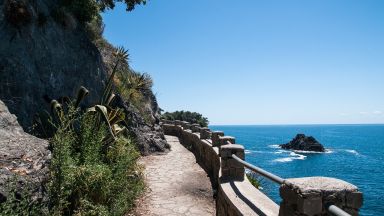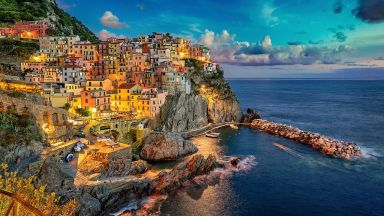Self Guided Walking Tour of Florence (With Maps!)
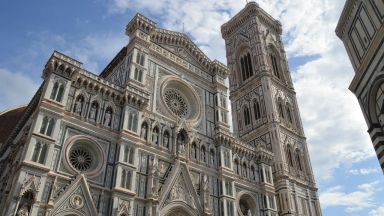
This website uses affiliate links which earn a small commission at no additional cost to you.
Florence, located in Italy’s Tuscany region, serves as its capital. It’s an exquisite city boasting centuries of history and showcasing remarkable Renaissance art and architecture. Among its renowned landmarks are the iconic Florence Duomo, the Galleria dell’Accademia, where Michelangelo’s masterpiece sculpture “David” is housed, and the Uffizi Gallery.
Whether you have just a day to explore Florence or an extended stay in this picturesque city, there’s an abundance of activities to keep you occupied. As one of my preferred Tuscan cities, Florence never fails to offer fresh discoveries!
Uffizi Gallery
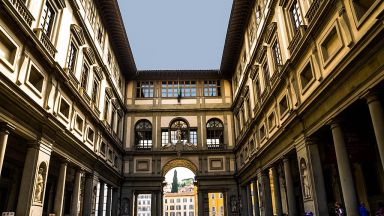
If you had to choose just one Renaissance location to visit in Florence or in the entire world, the most obvious and compelling choice would be the Uffizi Gallery. Housed in the Palazzo degli Uffizi, originally intended as the offices of magistrates, this magnificent structure was constructed in the 16th century by Giorgio Vasari for Cosimo Medici, the first Duke of Florence. It became an ideal space to house the Medici family’s remarkable art collection and has grown to become one of Florence’s most popular tourist attractions.
The Uffizi Gallery boasts an awe-inspiring collection of must-see works of art, including masterpieces by Sandro Botticelli, Leonardo da Vinci, Michelangelo, and Caravaggio, among others. The interior decoration, particularly the intricate ceilings, is equally spectacular and worth exploring. With over 50 lavish rooms to wander through, visitors may find it challenging to absorb everything in one visit. Taking a break and recharging at the on-site café with a terrace is highly recommended, offering unparalleled views of Florence.
Due to its world-class status, the museum is often crowded, and long queues are not uncommon, especially during peak seasons. Booking tickets in advance through the official website can significantly reduce wait times and may offer discounted rates.
The Uffizi’s internal courtyard, designed by Vasari, is a long and narrow space opening towards the Arno River through a Doric screen, and its innovative architectural features set a precedent for standardized streetscapes in Europe. Michelangelo’s masterpieces, including “David” and the “Doni Tondo,” can also be admired within the gallery, displaying his extraordinary talent as both a sculptor and a painter.
Overall, the Uffizi Gallery is a true treasure trove of Renaissance art and a captivating experience that immerses visitors in the beauty of history and creativity.
Location: Uffizi Gallery, Piazzale degli Uffizi, Florence, Metropolitan City of Florence, Italy | Website | Skip-the-Line Uffizi Small Group Tour Available!
Read more about Uffizi Gallery
Museo Galileo
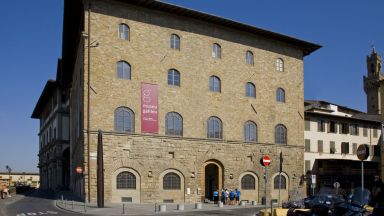
From the Uffizi Gallery walk under the archway and onto the road overlooking the Arno river. Turn left and the next building you come to is the Uffizi Gallery.
The museum dedicated to Galileo Galilei in Florence is a remarkable tribute to the renowned scientist and a must-visit destination for anyone interested in the history of science and astronomy. Galileo, born in Pisa in 1564, made groundbreaking discoveries that revolutionized our understanding of the universe. His telescopes and lens, which played a pivotal role in observing Jupiter’s moons, are on display, providing a unique opportunity to connect with the scientific legacy of this great mind.
One of the highlights of the museum is the large-scale reconstructions of Galileo’s experiments on motion, weight, velocity, and acceleration. These interactive displays, sometimes demonstrated by knowledgeable staff members, offer visitors a hands-on experience of the scientific principles Galileo explored.
The museum also pays homage to the Academy for Experimentation (“Accademia del Cimento”), founded in 1657 in Florence, making it the world’s first scientific institution. The academy was established as a tribute to Galileo, and its pioneering inventions are proudly showcased here. Early thermometers, hygrometers, and barometers developed by the academy members provide fascinating insights into the early advancements in scientific instruments.
Aside from Galileo’s contributions, the museum features other historical artifacts related to exploration and navigation. The 1554 world map created by Portuguese cartographer Lopo Homem and the nautical instruments devised by Sir Robert Dudley are just some of the treasures that visitors can admire during their visit.
Overall, the museum dedicated to Galileo Galilei is a journey through the scientific legacy of one of history’s most influential figures. It offers a unique opportunity to appreciate the wonders of astronomy, scientific experimentation, and the remarkable innovations that emerged during Galileo’s time.
Visiting Museo Galileo: Daily 09:30 – 18:00, Tuesday 09:30 – 13:00 € 13,00 Buy Now
Location: Museo Galileo, Piazza dei Giudici, Florence, Metropolitan City of Florence, Italy | Hours: Daily 09:30 - 18:00 | Price: Adults: €13.00 | Website | Buy Museo Galileo Entry Tickets Here!
Read more about The Museo Galileo (Galileo Museum), Florence
Piazza della Signoria
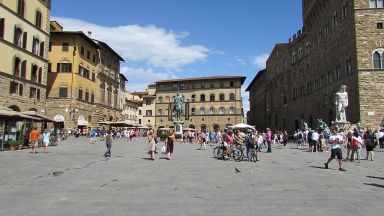
From the entrance turn left and walk down Via dei Castellani. Turn second left into Via della Ninna.
Signoria Square, located alongside the Cathedral Square, is a significant center of attraction in Florence and serves as the city’s civil heart. Dominated by the formidable Palazzo Vecchio, a fortified palace, the square is steeped in historical importance as it was the birthplace of the Florentine Republic. This square holds a special place in the hearts of the locals, serving as a hub of social life and evoking images of Michelangelo’s “David,” which once stood here in its original location, now replaced by a replica.
The square’s central location dates back to Roman times when it was a small town called Florentia, surrounded by a theatre, baths, and a textile workshop. Over the centuries, various additions were made, including a church, a loggia, and an enormous 5th-century basilica, as revealed during excavations in the 1980s.
One of the captivating aspects of Signoria Square is its asymmetrical shape and the multitude of artworks it houses, both large and small. This makes it a favourite spot for photographers, who capture the square’s beauty from various angles. Even without a camera, standing in the middle of the square and taking in the 360-degree view is a mesmerizing experience.
The square is dominated by the formidable Palazzo Vecchio, a fortified palace. Adjacent to it is the “Loggia dei Lanzi” or Lanterns’ Lodge stands, functioning as an open-air museum accessible to the public free of charge. The lodge boasts an impressive collection of statues, including the renowned “Rape of the Sabine Women,” “Hercules and the Centaur,” and a bronze “Perseus,” all strategically positioned to engage the visitors.
Location: Piazza della Signoria, Piazza della Signoria, Florence, Metropolitan City of Florence, Italy
Read more about Piazza della Signoria
Palazzo Vecchio (Old Palace)
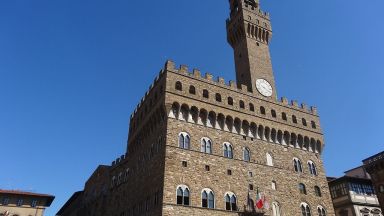
The Palazzo Vecchio, also known as the Old Palace, is an essential site to visit in Florence, offering a profound understanding of the city’s history and culture. This grand Romanesque-style palace has been a significant seat of power in Florence since its construction in 1299, serving as the town hall for centuries and currently housing the office of the Florence mayor since 1872.
During the reign of Cosimo I de’ Medici, who became the Grand Duke, the palace underwent a transformation as it was enlarged and renovated in the Renaissance style. The palace’s facade is adorned with shields depicting the city’s political history and is embellished with a series of sculptures, including remarkable works like Michelangelo’s “David,” Donatello’s “Judith and Holofernes,” the “Hercules and Cacus,” and the heraldic lion symbolizing Florence known as “Marzocco.”
Exploring the Palazzo Vecchio offers a captivating journey through time. From the grand Hall of the Five Hundred (“Salone dei Cinquecento”), designed to celebrate the Duke’s victories, to the more intimate quarters, visitors are immersed in historical intensity and artistic wonders. Giorgio Vasari’s iconographic program has adorned the private quarters of the Medici rulers with magnificent decorations, providing a glimpse into their secluded lives.
The palace’s Tower of Arnolfo is an additional attraction, and access may require an additional fee. Marvelling at the breath-taking ceilings in each room is a memorable experience, although it may lead to a crick in the neck due to their grandeur.
One of the remarkable sculptures in the grand hall is Michelangelo’s marble group, “The Genius of Victory.” Originally intended for Julius II’s tomb, the sculpture represents an allegory of triumph rather than a moment of battle. The expressive treatment of the surfaces and the contrast between the young and elegant genius and the dominated older captive create an extraordinary visual impact.
In addition to the museum, you can also climb the Torre di Arnolfo, tower of Palazzo Vecchio. The tower is 95 metres high and you have a great view over the city centre of Florence. You can also go up to the fortress wall. There are tickets for the museum, for the wall and for the tower individually or as a cheaper combination ticket.
Visiting Palazzo Vecchio (Old Palace):
Museum: €12.50 Friday to Wednesday 9:00 am – 7:00 pm and Thursday 9:00 am – 2:00 pm
Palazzo Vecchio Tower (Torre di Arnolfo): €12.50 Friday to Wednesday 9:00 am – 5:00 pm and Thursday 9:00 am – 2:00 pm
Top Tip for Visiting Palazzo Vecchio: The queues at the ticket counter in Palazzo Vecchio are often very long. Waiting for 2 hours or more is not uncommon. Skip the Line tickets for Palazzo Vecchio are available. These tickets without queuing are slightly more expensive at about €20.00. You also have the option of taking a Palazzo Vecchio Guided Tour (€50).
.
Location: Palazzo Vecchio, Piazza della Signoria, Florence, Metropolitan City of Florence, Italy | Hours: MUSEUM Monday/Tuesday/Wednesday/Friday / Saturday /Sunday - 9 a.m.-7 p.m. Thursday: 9 a.m - 2 p.m.TOWER Monday/Tuesday/Wednesday/Friday - 9 a.m.-5 p.m. Thursday: 9 a.m. - 2 p.m. Please arrive 15' before your visit | Price: Adults: €12.50 | Website | Palazzo Vecchio Guided Tour Available!
Read more about Palazzo Vecchio, Florence
Loggia dei Lanzi
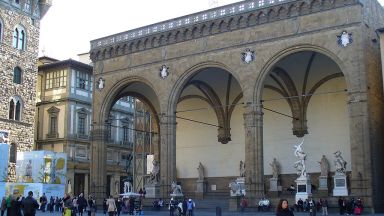
The 14th-century loggia that showcases remarkable works of art. Among these are Giambologna’s “Rape of the Sabine Women,” Benvenuto Cellini’s bronze “Perseus” (1554), and Agnolo Gaddi’s “Seven Virtues” (1384–89). The loggia derives its name from the Lanzichenecchi, Swiss bodyguards of Cosimo I, who were stationed here. Present-day guards continue this tradition, vigilantly monitoring crowd behaviour and strictly forbidding anyone from carrying food or drink within the area.
On the Loggia dei Lanzi, the statues are arranged in three rows. In the first row, there are two lions, and on the right and left of them stand two very well-known statues. In the middle row, there are three sculptures, and behind the back wall, there are six more statues.
Location: Loggia dei Lanzi, Piazza della Signoria, Florence, Metropolitan City of Florence, Italy
Read more about Loggia della Signoria or Loggia dei Lanzi
Complesso di San Firenze & Zeffirelli Museum
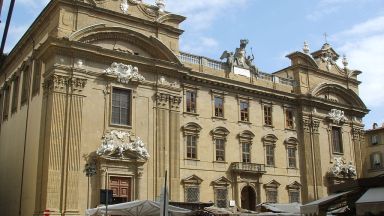
Walk past the Replica of statue of David and turn left at the Fountain of Neptune. The Palazzo Gondi built in 1490 is on your left. Turn left into Piazza di S. Firenze, the Complex of San Firenze, located on the southeast corner of San Firenze Square.
The complex of San Firenze (Complesso di San Firenze) in Florence is one of the rare examples of the Baroque style in the city, which now houses the Museum Zeffirelli (Museo Zeffirelli) and the Church of San Filippo Neri (Chiesa di San Filippo Neri). A part of it was used as the city court until a few years ago.
The museum exhibition at the Franco Zeffirelli Foundation takes visitors on a journey through Zeffirelli’s life and career, starting from his humble beginnings in 1953. The exhibition is organized into 20 chapters, each represented in different rooms, showcasing nearly 300 sketches, posters, fliers, costumes, set-design models, original drawings, and behind-the-scenes photographs from his film sets. Zeffirelli’s work includes notable films such as “Tea with Mussolini,” “Hamlet,” “Jane Eyre,” “The Taming of the Shrew,” and his acclaimed 1968 version of “Romeo and Juliet,” which earned him an Academy Award nomination. The museum also features a tearoom on the ground floor, extending into the palazzo courtyard, providing visitors with a pleasant space to relax. Adjacent to the tearoom, a store offers Zeffirelli’s books and film memorabilia, allowing enthusiasts to delve deeper into the legacy of this extraordinary filmmaker.
Visitng Zeffirelli Museum: €12, 10.00 to 18.00 from Tuesday to Sunday.
Location: Complesso di San Firenze, Piazza di San Firenze, Florence, Metropolitan City of Florence, Italy | Website
Read more about Complesso di San Firenze
Museo Nazionale del Bargello
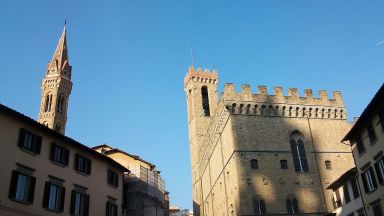
Continuing up Via del Proconsolo you soon come to the Museo Nazionale del Bargello on your right.
The Bargello Museum in Florence is a must-visit destination for architecture enthusiasts and art lovers alike. Housed in a medieval fortress, the museum boasts a remarkable collection of some of Italy’s most treasured sculptures and artworks. Originally known as the People’s Palace (“Palazzo del Popolo”), the Bargello is one of the city’s oldest structures, dating back to 1255. Over the centuries, the building has served various functions, including housing the “Captain of the People,” the chief of police in Florence, known as the “bargello,” which gave the palace its name. Later, it was used as a prison until the mid-19th century when it was transformed into a museum showcasing a vast array of Gothic and Renaissance sculptures.
Inside the museum, visitors can admire works by renowned artists such as Michelangelo, Verrochio, Brunelleschi, and Donatello, among others. Donatello’s statue of David is a particular highlight, as it holds great significance as the first male nude sculpture publicly exhibited since ancient times, representing a pivotal moment in the evolution of European art.
The Bargello’s inner courtyard provides an elegant space adorned with relief and freestanding sculptures, creating a picturesque setting for visitors to enjoy. The gallery, located off the courtyard, and the spacious exhibition area above house some of the museum’s most famous pieces.
In addition to its exceptional Renaissance treasures, the museum’s collection includes rare artifacts from the Byzantine, Roman, and Medieval periods. Visitors can also appreciate jewelry pieces from the European Renaissance and Islamic origins, adding to the diverse and enriching experience.
To enhance the visitor experience, all exhibits at the Bargello Museum are accompanied by English descriptions, ensuring that art enthusiasts from around the world can fully immerse themselves in the historical and artistic significance of the museum’s remarkable collection.
Visiting Museo Nazionale del Bargello: €11.00 Monday, Friday, Saturday and Sunday 08.15-18.50; Wednesday, Thursday. 08.15-13.50. Bargello Museum: Skip the Line Tickets
Location: Museo Nazionale del Bargello, Via del Proconsolo, Florence, Metropolitan City of Florence, Italy | Hours: 9 April to 30 September 2023 08.15-18.50 Monday, Friday, Saturday and Sunday 08.15-13.50 Wednesday, Thursday1 to 30 October 2023 08.15-18.50 Saturday and Sunday 08.15-13.50 Monday, Wednesday, Thursday and Friday | Price: Adults: €11.00 | Website | Reserved Entry Ticket to Bargello Museum
Read more about Bargello Museum in Florence
Badia Fiorentina - Monastero
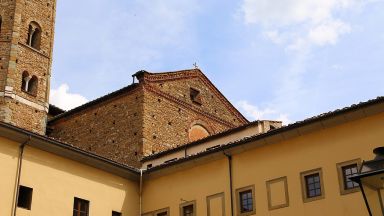
A little further up Via del Proconsolo on the opposite side of the road to the Bargello National Museum is the Badia Fiorentina – Monastero
The Badìa Fiorentina is a beautiful old monastery that is situated in the historical centre of Florence. It is also known as the Abbey of Santa Maria Assunta and is one of the five ancient abbeys of the city. It is located very close to where Dante grew up. Established in 978 by Willa, the widowed spouse of Count Uberto of Tuscany, it has witnessed centuries of religious and cultural significance. The tomb of their son, Count Ugo, sculpted by Mino da Fiesole, adds to the abbey’s historical importance and showcases the skilled craftsmanship of the Renaissance era.
Inside the church, visitors are treated to Filippino Lippi’s masterpiece, “The Virgin Appearing to St Bernard,” a captivating artwork that brings life and emotion to the sacred space.
Exploring the Chiostro degli Aranci, or “cloister of the orange trees,” provides a tranquil retreat within the abbey complex. Although the orange trees cultivated by the monks are no longer present, the cloister’s early frescoes and the glimpse of the hexagonal 14th-century campanile mentioned by Dante in “The Divine Comedy” create a unique and enchanting atmosphere.
Location: Badia Fiorentina - Monastero, Via del Proconsolo, Florence, Metropolitan City of Florence, Italy | Price: Free | Website
Read more about Badia Fiorentina
Casa di Dante (Dante House-Museum)
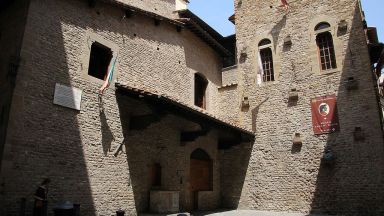
Continue up Via del Proconsolo and turn first left onto Via Dante Alighieri. The second turning on the right is the Museo Casa di Dante. It stands opposite the early 14th century Torre della Castagna. The tower is called Chestnut, as the city council that used to place chestnuts in special bags during voting.
During the Renaissance, Florence witnessed extensive reconstruction, yet the eastern part of the city retains a distinctive medieval atmosphere. As you wander through the intricate maze of narrow alleyways and concealed passages, you will encounter scenes that would still be familiar to Dante Alighieri, the beloved Italian poet. Casa di Dante, his former residence, still stands near the parish church where he first caught sight of his beloved Beatrice Portinari.
Inside the three-story house-museum, you will find a captivating display of artifacts that shed light on crucial moments in Dante’s life. The first floor is dedicated to his early years, while the second floor showcases documents relating to his exile in 1301 and the final chapters of his life spent in Ravenna. As you ascend to the top floor, you will be greeted by an extensive collection of Dante’s personal belongings, including original items and carefully crafted replicas. Among these treasures, take delight in the miniature copy of the “Divina Comedia,” a testament to its enduring legacy as the smallest printed edition.
In Dante’s epic poem, he embarks on a journey through Hell and Purgatory, guided by the poet Virgil, only to be led through Paradise by his beloved Beatrice. Although Dante initially referred to his work as the “Comedy,” it gained immense popularity. Eventually, a lavish edition published in Venice in 1555 assumed the title we now universally recognize.
Visitng Casa di Dante: €8.00 Winter: November 1 – March 31: Tue. – Fri. 10am – 5pm & Sat. and Sun. 10 a.m. – 6 p.m. Summer: April 1 – October 31: Daily 10am – 6pm
Location: Museo Casa di Dante, Museo Casa di Dante, Via Santa Margherita, Florence, Metropolitan City of Florence, Italy | Hours: November - March: Tuesday through Friday from 10 a.m. to 5 p.m; Saturday and Sunday from 10 a.m. to 6 p.m.;Closed on Mondays April - October: Open daily 10 a.m. to 6 p.m | Price: € 8,00 | Website
Read more about Museo Casa di Dante Alighieri
Cattedrale di Santa Maria del Fiore (Florence Cathedral)
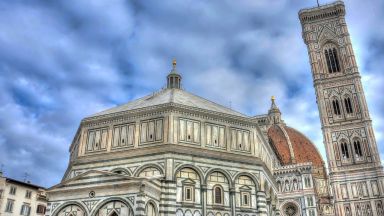
Walk along the lane to the side of the museum. Turn left into via del Corso and then first right onto Via dello Studio at the end of which lies Florence Cathedral.
Indeed, the Florence Cathedral, commonly known as the Duomo, is a true architectural marvel and a symbol of Renaissance ingenuity. Its dome, designed by Filippo Brunelleschi, remains an engineering wonder to this day. The entire cathedral complex, including the dome, is a testament to the skill and creativity of the Renaissance masters who contributed to its construction.
The construction of the cathedral took several generations of architects and craftsmen, and Brunelleschi’s innovative approach to completing the dome was a game-changer. His use of large-scale models and specially designed machinery demonstrated his genius as an architect and engineer. It is fascinating to know that Leonardo da Vinci, one of history’s greatest polymaths, was inspired by Brunelleschi’s machinery and created sketches of it.
The statue of Brunelleschi standing in the piazza in front of the Cathedral pays tribute to his contribution and serves as a reminder of the extraordinary effort that went into creating this architectural masterpiece.
Inside the Dome, the fresco “Dante and the Divine Comedy” by Domenico di Michelino adds to the artistic and historical significance of the Cathedral. Depicting the renowned poet Dante Alighieri holding his masterpiece, “The Divine Comedy,” alongside scenes from Hell, Purgatory, and Heaven, the fresco celebrates Dante’s legacy. The inclusion of depictions of 15th-century Florence in the painting offers a unique perspective on the city’s history.
The exterior of the Cathedral, with its intricate mix of marbles, is another splendid aspect of the structure. The skilful combination of marbles creates a visual spectacle, almost resembling a work of art rather than solid stone.
Visiting Florence Cathedral: There are 3 types of ticket available see https://operaduomofirenze.skiperformance.com/
- Ghiberti Pass €15.00
- Santa Reparata (Cathedral) : daily from 10 a.m. to 5 p.m., but on Sundays only from 1:30 p.m. to 4:45 p.m., probably because there is a service in the morning.
- Baptistery: Mon – Sat: 8:15 to 10:15, then small break and again from 11:15 to 19:30. On Sunday continuous from 8;15 to 13:30.
- Cathedral-Museum Florence: opening hours every day from 9 to 19 o’clock
- Giotto Pass €20.00 (The above plus)
- Giotto’s Bell Tower: Very long opening hours every day from 8:20 to 19:15, also on weekends.
- Brunelleschi Pass €30.00 (The above plus)
- Brunelleschi’s Dome: 8:30 a.m. to 7 p.m., on weekends shorter in the evening (Saturday to 5 p.m., Sunday to 4 p.m.).
Location: Cathedral of Santa Maria del Fiore, Piazza del Duomo, Florence, Metropolitan City of Florence, Italy | Hours: Generally open from 10.45am - 4.30pm Sundays and religious holidays: closedDuring Holy week - Holy Thursday: 12:30 - 4:30pm Good Friday: 10:30am - 4:30pm Holy Saturday: 11am - 4:45pm | Website | Guided Tour (includes Cathedral, Duomo Museum, and Baptistery)
Read more about Cathedral of Santa Maria del Fiore & Piazza Duomo
Campanile di Giotto (Giotto's Bell Tower)
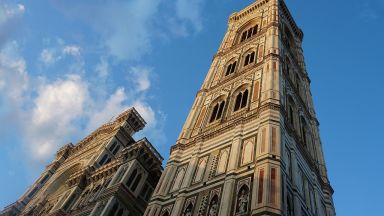
The famous Giotto’s Bell Tower is a freestanding belfry belonging to the Santa Maria del Fiore Cathedral in Florence. It was designed by the acclaimed painter and architect Giotto di Bondone, after whom it is named. Giotto is widely regarded as the first of many great Italian artists who contributed to the Renaissance. Soaring to a height of 85 metres, this tower stands as an exceptional example of Florentine Gothic architecture, adorned with intricate sculptural decorations and vibrant marble embellishments.
Tragically, Giotto passed away during the tower’s construction, and the project had to be completed by two other architects. Besides his contributions to Renaissance architecture, Giotto also left his mark as a skilled painter and sculptor. His artistic legacy is evident in the exquisite white, green, and red marble adornments on the tower, as well as the grand figurative cycle within the belfry, which he left unfinished.
Exploring the interior of the tower is possible, and out of the three major tall structures in Florence, climbing this one is arguably the easiest. Despite the seemingly daunting 414 steps, the staircase is designed in a way that allows for rest stops along the way. Each level within the tower houses a large bell, totaling seven bells—one for each musical note. Unlike the crowded spaces of the Duomo Cathedral and the Arnolfo Tower in the Old Palace (or “Palazzo Vecchio”), the resting areas within Giotto’s Tower are relatively spacious and engaging, offering visitors diverse and remarkable views of the city below.
From the very top, one can observe the Cathedral’s dome and the Baptistery of San Giovanni from a unique and somewhat unconventional perspective. The sweeping view of Florence includes its timeless alleys and rooftops that have retained much of their charm over the past five centuries.
Location: Campanile di Giotto, Cattedrale di Santa Maria del Fiore, Piazza del Duomo, Florence, Metropolitan City of Florence, Italy | Skip the Line Duomo Complex Tour with Giotto Tower Ticket Available!
Read more about Campanile di Giotto (Giotto's Bell Tower)
Battistero di San Giovanni (Baptistery of St. John)
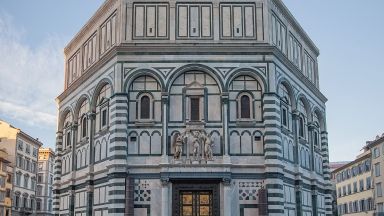
The exquisite Florence Baptistry, named after Saint John the Baptist, the patron saint of the city, is located in the Cathedral Square and San Giovanni Square, diagonally opposite the Duomo Cathedral. It was constructed in the 7th century atop a Roman structure believed to have been a temple dedicated to Mars. The baptistery has an octagonal shape, a common feature of baptisteries since early Christian times. The number eight symbolizes regeneration in Christianity, representing the six days of creation, the day of rest, and the day of re-creation through the sacrament of baptism.
During its reconstruction in 1059, the baptistery was adorned with white and dark green marble, creating a striking zebra-like pattern. However, it is most renowned for its three sets of bronze doors. The south doors, designed by Andrea Pisano, depict scenes from the life of St. John and elegantly illustrate the eight virtues of Christianity in bronze. The north doors, crafted by Lorenzo Ghiberti, took him 21 years to complete and portray the life of Christ. Ghiberti was then commissioned to create the east door, on which he worked for an additional 27 years. These doors were famously dubbed by Michelangelo as the “Gates of Paradise,” and the ten panels on this door depict “the Story of Joseph.”
Inside, visitors can admire magnificent mosaics adorning the ceiling and a baptismal font that has been in place since 1576, used for the baptism of the son of Francesco I de’ Medici, the ruler of Florence. Besides members of the Medici family, the baptistery witnessed the baptisms of many Renaissance-era personalities and almost all Catholic Florentines until the 19th century. Exploring this architectural marvel is, therefore, a journey into the rich Catholic history of Florence.
Location: The Baptistery of St. John, Piazza San Giovanni, Florence, Metropolitan City of Florence, Italy | Hours: Sundays 8:15 am to 1:30 pm, Tuesday-Friday 8:15 to 10:15 am, 11:15 am to 7:30 pm, Saturdays 8:15 am to 7:30 pm. | Price: A cumulative ticket to the entire Duomo complex costs €18 and is valid for 72 hours after the first entry. | Website | Baptistry Small-Group Tour (Includes Dome Climb, Museum)!
Read more about Battistero di San Giovanni (Baptistery of St. John)
Palazzo Medici Riccardi (Medici Riccardi Palace)
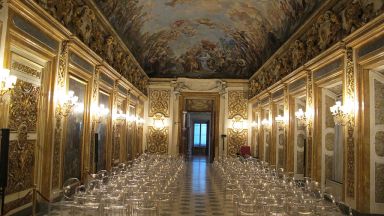
Walk down Via dei Servi to the north east of the Cathedral. Turn left down Via de’ Pucci. On your right is the Palazzo Pucci, owned by the aristocratic Pucci family since around 1480. The present palace was designed around 1748 by the architect Paolo Falconieri. Walk on another two blocks until you come to Riccardi Medici Palace.
The first Medici palace, once the residence of Cosimo the Elder and Lorenzo the Magnificent, served as a bustling hub for numerous prominent Renaissance artists, including the prodigious Michelangelo, who was discovered by Lorenzo while still in his formative teenage years.
This grand edifice was an imposing spectacle of its time, setting a new standard with its three tiers of progressively textured stonework and sizeable, evenly spaced two-light windows. A magnificent cornice adorned the entire exterior, exemplifying its imposing presence. The building encloses an elegant square courtyard at its core, in stark contrast to the commanding impression projected by its façade. Together, they symbolize the duality of the Medici family, projecting an image of wealth, influence, and even ruthlessness to the outside world, while fostering an atmosphere of refinement as patrons of the humanist Renaissance within their sanctuary.
While the courtyard and gardens offer a delightful and complementary experience, it is undoubtedly worthwhile to pay the admission fee and ascend to the upper rooms. These spaces exhibit designs, decor, style, furnishings, and collections that bear testament to the profound power, far-reaching influence, and immense wealth of the Medici dynasty.
A hidden gem within the palace is the Magi Chapel, mesmerizing with its diminutive size yet resplendent floor-to-ceiling frescoes by the gifted artist Benozzo Gozzoli. The intricate details within the artwork, such as the elaborate costumes, depictions of animals, and picturesque scenery, captivate the observer’s gaze. One can spend an hour studying the reputed likenesses of various members of the illustrious Medici clan, along with notable figures like the Wolf of Rimini: Sigismondo Malatesta. The vibrant colours – considering the work was started in 1459 – create a visual feast where the composition unfolds in a bit of a whirlwind.
Near the end of the tour is the astonishing Galleria, a completely “over-the-top” Baroque marvel, resplendent with walls covered in shimmering gold and a grand domed ceiling adorned with scenes from Greek mythology. Additionally, there is an underground sculpture museum, housed within the former stables. Fortunately, there are minimal queues for entry, allowing visitors to relish the magnificence of the rooms comfortably and at their leisure.
Location: Medici - Riccardi Palace, Via Camillo Cavour, Florence, Metropolitan City of Florence, Italy | Hours: Monday to Sunday 9 am – 7 pm | Price: €10 / €7 | Free with Firenze Card. | Website | Part of the Medici Family History Tour
Read more about Medici Riccardi Palace
The Medici Chapels & Basilica di San Lorenzo
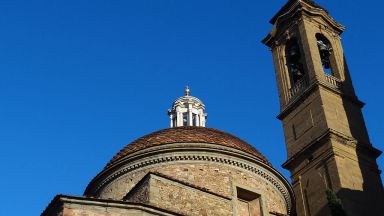
Continue along the road to the square and the Basilica di San Lorenzo.
The first Medici palace, once the residence of Cosimo the Elder and Lorenzo the Magnificent, served as a bustling hub for numerous prominent Renaissance artists, including the prodigious Michelangelo, who was discovered by Lorenzo while still in his formative teenage years.
This grand edifice was an imposing spectacle of its time, setting a new standard with its three tiers of progressively textured stonework and sizeable, evenly spaced two-light windows. A magnificent cornice adorned the entire exterior, exemplifying its imposing presence. The building encloses an elegant square courtyard at its core, in stark contrast to the commanding impression projected by its facade. Together, they symbolize the duality of the Medici family, projecting an image of wealth, influence, and even ruthlessness to the outside world, while fostering an atmosphere of refinement as patrons of the humanist Renaissance within their sanctuary.
While the courtyard and gardens offer a delightful and complementary experience, it is undoubtedly worthwhile to pay the admission fee and ascend to the upper rooms. These spaces exhibit designs, decor, style, furnishings, and collections that bear testament to the profound power, far-reaching influence, and immense wealth of the Medici dynasty.
A hidden gem within the palace is the Magi Chapel, mesmerizing with its diminutive size yet resplendent floor-to-ceiling frescoes by the gifted artist Benozzo Gozzoli. The intricate details within the artwork, such as the elaborate costumes, depictions of animals, and picturesque scenery, captivate the observer’s gaze. One can spend an hour studying the reputed likenesses of various members of the illustrious Medici clan, along with notable figures like the Wolf of Rimini: Sigismondo Malatesta. The vibrant colors – considering the work was started in 1459 – create a visual feast where the composition unfolds in a bit of a whirlwind.
Near the end of the tour is the astonishing Galleria, a completely “over-the-top” Baroque marvel, resplendent with walls covered in shimmering gold and a grand domed ceiling adorned with scenes from Greek mythology. Additionally, there is an underground sculpture museum, housed within the former stables. Fortunately, there are minimal queues for entry, allowing visitors to relish the magnificence of the rooms comfortably and at their leisure.
Location: Cappelle Medicee, Piazza di Madonna degli Aldobrandini, Florence, Metropolitan City of Florence, Italy | Reserved Entrance Ticket to the Medici Chapel
Read more about The Medici Chapels & Basilica di San Lorenzo
Piazza della Repubblica
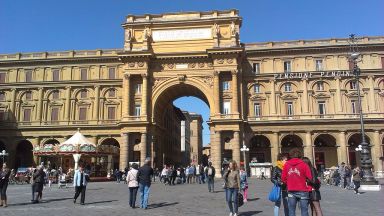
Head back towards Riccardi Medici Palace and turn right down Borgo S. Lorenzo. You pass the Battistero di San Giovanni and soon arrive at Piazza della Repubblica.
.
The Piazza della Repubblica stands as the center of Florence. The Colonna dell’Abbondanza, or Column of Abundance, signifies the exact geographical midpoint of the city, originally the ancient midpoint of the Roman Forum. It also serves as the boundary between three of Florence’s four historic neighborhoods on this side of the Arno River: the Santa Croce azzurri, San Giovanni verdi, and Santa Maria Novella rossi; while the Santo Spirito bianchi neighborhood is situated in the Oltrarno district across the river.
A part of the current piazza was once used as a market due to its significance in terms of commerce, politics, and social activities in the city. Many stories and tales related to Florence originate from this square. According to one such tale, in 1245, St. Peter Martyr was trying to preach to a large crowd when the devil, disguised as an imposing black horse, attempted to disturb the onlookers by running wildly through the market and endangering them. Recognizing the danger, St. Peter raised his arm and made the sign of the cross towards the skittish horse, which immediately stopped and vanished. Centuries later, in memory of this event, Bernardo Vecchietti commissioned Giambologna to create a bronze standard-bearer in the shape of a small devil, placing it at the corner of his palace between Via Vecchietti and Via Strozzi.
The current appearance of the piazza can be attributed to urban renovations that took place during Florence’s period as the capital of the Kingdom of Italy, known as the Risanamento. During this time, older buildings, including medieval towers and noble palaces, were demolished and replaced with elegant structures, including the historic Caffè Le Giubbe Rosse, which transformed Piazza della Repubblica into a sophisticated center of public life.
Location: Piazza della Repubblica, Florence, Metropolitan City of Florence, Italy
Read more about Piazza della Repubblica, Florence
Palazzo Davanzati
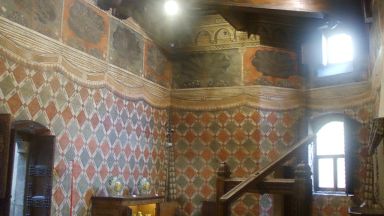
Walk directly across the Piazza and right into Via Porta Rossa.
The Davanzati Palace, originally constructed in the 14th century as the residence of the Davizzi family, who were merchants and bankers, now bears the name of the Davanzati family, who were bankers for the Popes at Avignon. The Davanzati family acquired the palace in 1578 and added their large coat of arms to the facade. Today, the palace is open to the public as the Museum of the Old Florentine House, offering a captivating and invaluable glimpse into a typical wealthy Florentine home from the Medieval to Renaissance era. Visitors can explore frescoes, paintings, sculptures, and period furniture that adorn the interior.
To visit the upper floors of the palace, which showcases the rooms where a wealthy family would have lived, including a kitchen equipped with period-appropriate equipment, a guide is required. Visitors can either book in advance on the website or arrange a time with the receptionist. It is highly recommended to see these upper floors, as the bedrooms, in particular, boast stunning wall paintings. However, the lower floors, holding delightful collections of embroidery and lace-making, can also be visited without a guide.
For older children, this experience will be both educational and fascinating, surpassing any description in a history schoolbook. The Museum of the Old Florentine House offers a unique opportunity to step back in time and immerse oneself in the opulence and lifestyle of a wealthy Florentine family during the Medieval and Renaissance periods.
Location: Palazzo Davanzati, Via Porta Rossa, Florence, Metropolitan City of Florence, Italy | Hours: 08.15-13.50 Tuesday, Wednesday, Thursday 13.15-18.50 Friday, Saturday, Sunday (2nd and 4th of the month) | Price: €7.00 or Cumulative ticket for Bargello, Medici Chapels, Davanzati, Orsanmichele and Casa Martelli: € 22.00 | Website
Read more about Palazzo Davanzati
Ponte Vecchio
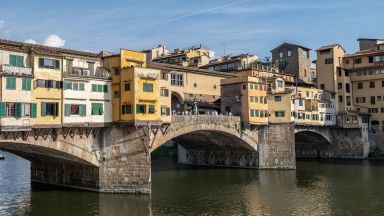
Head back along Via Porta Rossa and turn right into Via Calimala.
The Ponte Vecchio, also known as The Old Bridge, first appeared in documents in 996. During World War II, while all the other six local bridges crossing the Arno River were destroyed by retreating German forces, Ponte Vecchio was miraculously spared. This Medieval stone arch bridge stands as a testament to the lasting legacy that a monarch can create.
Today, the bridge is still lined with shops, just as it was in the Middle Ages. These days, the shops are occupied by jewelers, art dealers, and souvenir sellers. However, in the past, the bridge’s tenants were all butchers who disposed of rotten animal carcasses directly into the river below. It wasn’t until the 16th century when Grand Duke Fernandino I de’ Medici ordered that all the butcher shops be replaced by goldsmiths. This not only got rid of the unpleasant smell but also transformed the bridge into one of the most charming and golden spots in Italy.
From a distance, the bridge reveals a fascinating secret—a hidden upper level that features a kilometer-long tunnel connecting the Pitti Palace with the Old Palace. Historically, this tunnel provided a secure route for Duke Fernandino to move between the two palaces discreetly when he felt uneasy in public. Although the passageway has been closed for safety reasons since 2016, the Uffizi Gallery has exciting plans to reopen it.
One of the legends surrounding the bridge is the origin of the economic term “bankruptcy.” The story goes that a money-changer who couldn’t pay his debts had his trading table physically broken by soldiers as punishment for his insolvency. The table was called “banco,” and from this incident, the term “bancorotto” came into existence.
Today, the Old Bridge offers a delightful stroll, especially in the evenings, if it’s not packed end to end with thousands of tourists crossing the river over its cobblestones.
Location: Ponte Vecchio, Ponte Vecchio, Florence, Metropolitan City of Florence, Italy | Hours: 24 Hours | Price: Free
Read more about Ponte Vecchio
Palazzo Pitti (Pitti Palace)
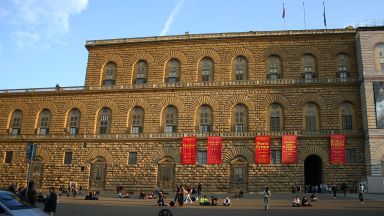
The Pitti Palace is truly an architectural marvel in Florence, and missing a visit to this splendid site would be a regrettable omission. Its main highlight is undoubtedly the stunning Renaissance architecture, complemented by the breathtaking gardens that offer new adventures at every turn.
Today, the enormous palace houses several museums under one roof. However, its origins trace back to being the official residence of the immensely powerful Medici family from the 16th to the 18th century. Initially built in the second half of the 15th century for Luca Pitti, the construction remained unfinished at the time of his death in 1472. In 1550, the palace was acquired by Eleonora di Toledo, the wife of Grand Duke Cosimo I de’ Medici. Later, when the Medici dynasty ended, the property passed into the hands of the House of Lorraine, and during the early 19th century, Napoleon Bonaparte used it as a power base during his rule over Italy.
Every aspect of this palace exudes elegance and sophistication, whether it’s the Palatine Gallery featuring over 500 paintings, the opulent Royal Apartments of the Medicis, the “Medici Treasury” housing priceless 15th-century silver, the Costumes Gallery, or the Porcelain and Carriages Museums. The impressive painted ceilings, walls, and intricate ground decorations create an ambiance of a private royal residence. Remarkably, since 1919, the palace and all its contents have belonged to the Italian people, attracting over 5 million visitors each year.
Visiting the Pitti Palace offers an extraordinary opportunity to immerse oneself in the grandeur and cultural richness that defines Florence’s history and artistic legacy.
Location: Palazzo Pitti, Piazza de' Pitti, Florence, Metropolitan City of Florence, Italy | Hours: From Tuesday to Sunday from 8.15am to 6.30pm | Price: Full €11 (Pitti + Boboli: €15) | Website | Skip the Line Tickets Available!
Read more about Palazzo Pitti
Forte di Belvedere
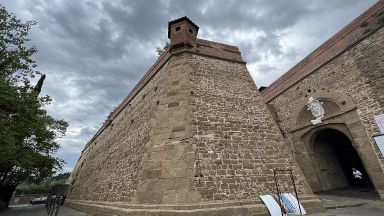
Fort Belvedere stands as a remarkable example of Italian Renaissance and military architecture, dating back to the end of the 16th century when it was built by Grand Duke Ferdinando I de’ Medici. This grand fortress served a dual purpose: to protect the city of Florence and to showcase the power and prestige of the Medici Family. It also functioned as a repository for the Medici’s treasury and offered a secure refuge for the Grand Duke during times of potential attack. To facilitate this, the fort was connected to the Old Palace (“Palazzo Vecchio”) via a corridor over the Old Bridge (“Ponte Vecchio”), as well as through other passages linking it to the Pitti Palace and Boboli Gardens.
From a military perspective, Fort Belvedere, being the largest fortress in Florence, occupied a strategic vantage point over the city and its surroundings. In the context of warfare during the Renaissance period, forts played a crucial role in defense strategies, and Belvedere excelled as a citadel and garrison for over a century after its completion. Its walls were intentionally positioned at angles to one another, enabling effective observation and, if necessary, crossfire to defend the neighboring walls. Interestingly, the renowned scientist Galileo Galilei used the fort for astronomical observations and, following his life imprisonment sentence in 1633, resided nearby at Villa Arcetri.
After undergoing a five-year renovation to enhance safety measures, the fort reopened to the public in July 2013, now primarily serving as an exhibition center. The nominal entry fee is well worth it, as visitors can freely explore the site and enjoy breathtaking panoramic views of Florence and the surrounding hills. Fort Belvedere remains a captivating testament to the rich history and architectural prowess of the Italian Renaissance period.
Location: Forte Belvedere, Via di San Leonardo, Florence, Metropolitan City of Florence, Italy
Read more about Forte Belvedere
Basilica di San Miniato al Monte
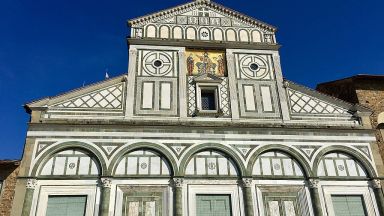
San Miniato, perched on one of the highest points in Florence, is celebrated as one of the most exquisite examples of Romanesque architecture in Tuscany and one of Italy’s most splendid churches. Though it may present challenges for those with limited mobility, it forms a delightful combination with the nearby Michelangelo Square (“Piazzale Michelangelo”). The best part is that admission to San Miniato is completely free, allowing visitors to explore the church and the adjacent Olivetan monastery, situated to the right of the basilica as they ascend the stairs.
According to legend, St. Miniato, also known as Minas, an Armenian prince serving in the Roman army under Emperor Decius, was denounced as a Christian after becoming a hermit. He was brought before the Emperor, who ordered him to be thrown to wild beasts in an amphitheater. Surprisingly, a panther summoned to attack him refused to harm him. Despite eventually being beheaded in the presence of the Emperor, St. Miniato is said to have picked up his own head, crossed the Arno River, and ascended the hill of Mons Fiorentinus to his hermitage. A shrine was later established at this spot, followed by a chapel in the 8th century.
The present-day basilica was funded by a guild of cloth merchants, who took responsibility for its upkeep. Adorned with stunning mosaic decorations, an exquisite marble inlay altar, and even a “pagan” horoscope, the basilica is a spectacular sight, showcasing remarkable craftsmanship by some of Florence’s most esteemed artists. San Miniato’s architectural beauty and historical significance make it a must-visit destination for those exploring the cultural treasures of Florence.
Location: San Miniato al Monte, Via delle Porte Sante, Florence, Metropolitan City of Florence, Italy | Hours: Monday-Saturday 9:30-13:00; 15:00-19:00 Sunday 8:15-13:00; 15:00-19:00 | Website
Read more about San Miniato al Monte
Piazzale Michelangelo (Michelangelo Square)
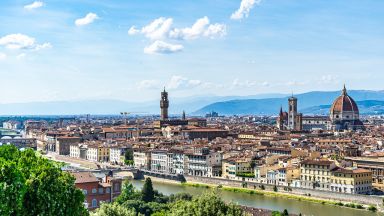
Florence undeniably captivates with its stunning beauty, and Michelangelo Square stands as irrefutable proof of this fact. Designed by Giuseppe Poggi, this expansive space, adorned with souvenir stalls, offers a magnificent panorama of Florence’s rooftops. The most iconic and photographed view from here showcases the Duomo Cathedral and its cupola, along with the Giotto Bell Tower and the Old Palace (“Palazzo Vecchio”). Over time, this famous vista has graced countless postcards, yet other notable landmarks can also be spotted nearby, such as Fort Belvedere, the Holy Cross Basilica (“Santa Croce”), and the Old Bridge (“Ponte Vecchio”).
The square itself was laid out in 1869 when Florence served as the capital of Italy, during an urban renewal program known as the “Risanamento” or “Rebirth” of the middle class.
Dedicated to the renowned Renaissance sculptor Michelangelo, the square features replicas of some of his works found elsewhere in Florence, including the famous “David” and the four allegories from the Medici Chapel of San Lorenzo. While the originals are crafted from white marble, the bronze copies displayed here were transported uphill by nine pairs of oxen, likely leaving them rather sweaty, to fulfil Giuseppe Poggi’s visionary concept.
Thousands of visitors flock here to witness the sunset, which is truly a sight to behold. Finding the perfect spot, you can revel in the sun’s reflection on the Arno River while sipping a glass of wine. Bringing your own drink is a good option, unless you prefer to take advantage of the various restaurants and bars situated around the square, with the most renowned boasting a Neoclassical design. Considering the prime location, prices here are actually quite reasonable.
Midway up the main staircase, you’ll discover a delightful city rose garden, where you can spend a serene half-hour strolling amidst the trees and roses, enjoying enchanting views of the Duomo and the cityscape.
After sunset, you can easily descend the hill, relishing the tranquillity of dusk along the way. Michelangelo Square provides an unforgettable experience that captures the essence of Florence’s timeless charm.
Location: Piazzale Michelangelo, Piazzale Michelangelo, Florence, Metropolitan City of Florence, Italy | Hours: 24 Hours | Price: Free
Read more about Piazzale Michelangelo
This website uses affiliate links which earn a small commission at no additional cost to you.
